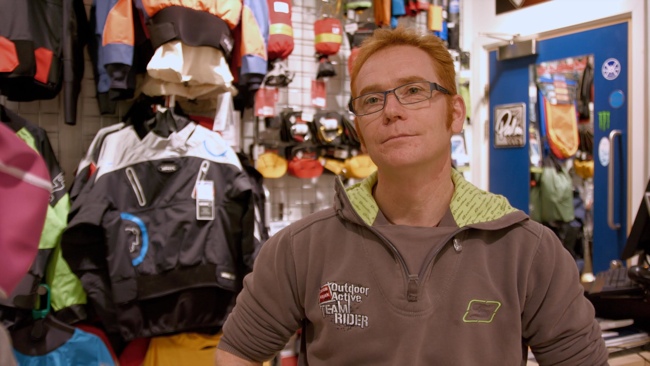
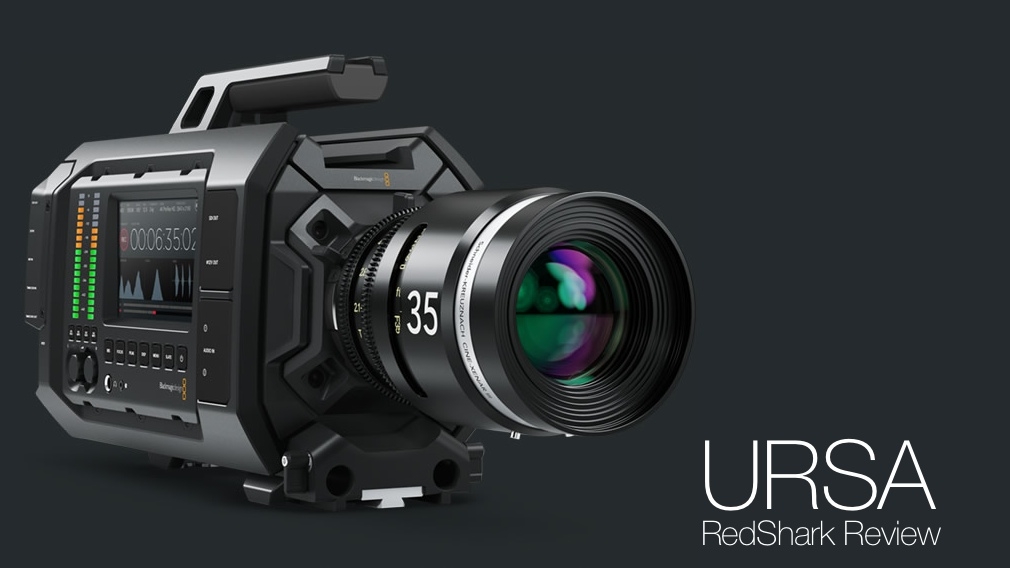 Blackmagic URSA Review
Blackmagic URSA Review
Simon Wyndham reviews the beefy and featured-laden URSA 4K camera from Blackmagic Design paired with a Zeiss CP.2 50mm PL-mount lens lens.
With the sheer choice on offer, you cannot buy a bad camera in today's market. A bold statement to make, perhaps, but one that I believe is true. Some cameras do certainly perform better than others, while some have better specifications and features, but I can say without reservation that, if you so chose any person with skill, you could make something of great quality with any of the pieces of gear on sale today.
What we have now is a buyer's market. Where once the only serious choice was between Sony and Panasonic, we now have a multitude of manufacturers who all offer well specced gear, including cameras made by companies who had previously only dealt with I/O hardware, namely Blackmagic and AJA.
Whilst Blackmagic's previous forays into the world of cameras have been developments on the video DSLR form, its new camera, the URSA, has made bold promises to change the way that we think about camera design. Now that I've been lucky enough to now test one, how does the URSA stack up in the real world?
Overview
The URSA is Blackmagic's first exploration into what could be considered a serious EFP (Electronic Field Production) camera. With its current firmware, the URSA is a lower-priced alternative to Sony's F5, featuring 12 stops of dynamic range, an interchangeable sensor block, global shutter sensor as standard, 4K RAW and Prores recording, as well as being able to record 4K at up to 80fps with the latest software update for fantastic slow motion. It is clear that with the URSA, Blackmagic means business.
First impressions
Before you have even opened the box for the URSA ,you will receive immediate feedback through your arms, with regard to one part of the camera's specification: the weight. Make no mistake, this is a heavy camera. At 16.32lbs, it is heavier than some of Sony's old Beta SP tape cameras.
There are a few reasons for the URSAs' weight. First and foremost, it is designed to last. The entire chassis, including the external panels and the large LCD screen housing, the whole lot, is made out of black anodised metal.
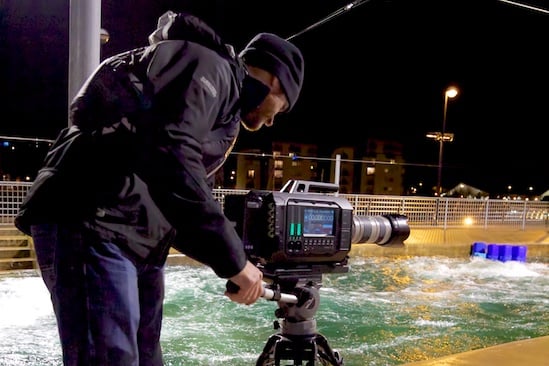
Could they have made it out of lighter weight material? Possibly, but it has to be considered that the URSA not only contains an awful lot of internal processing grunt (to account for future developments and upgrades), but the metal body also provides a massive amount of heat dissipation, when combined with the liquid and fan cooling.
The URSA is a beast indeed. With its sculpted lines and matte black paint scheme, this is a camera that looks the business and is built like a proverbial tank.
Design and features
At the front end of the URSA, you'll find the removable sensor block. Once again made out of machined metal, this is replaceable by undoing four chunky allen key bolts.
This is one of the main selling points of the URSA in that, when even better chip technology comes along, you will not have to replace the entire camera. It also has huge benefits if it is possible to purchase the different blocks separately. You could, for instance, have a PL mount cinema camera one day and swap for the B4 lens mount with a built in ND wheel the next for ENG or freeform documentary-style work.
Built into the body at the base is a 15mm rail mount with a VCT-14 compatible wedge plate. This is fantastic news for those who are fed up with having to purchase such things for each camera from third parties.
The top of the camera is home to the substantial top handle, which is mounted via a very chunky allen key bolt. The handle itself features four large screw holes for mounting accessories. Underneath the handle are five more accessory bolt holes, with a sixth being revealed when the handle is removed.
At the back of the camera, there are mounting holes for battery plates. In the case of the review sample, this was a V-lock system. Next to this are a multitude of BNC connections featuring SDI in, SDI out, Reference in, Timecode in, Timecode out and, beneath this, a four pin XLR 12v power input.
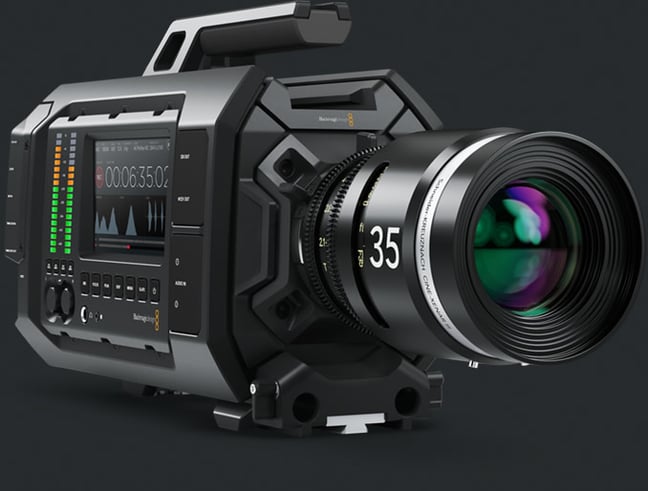
The right hand side of the camera is where many of Blackmagic's efforts start to show themselves. A centralised 5" touch screen is accompanied by large bright LED VU meters with dBFS markings, volume control knobs, iris, focus, peaking, display selection, menu, slate and power buttons.
This side of the camera also features a headphone output, which to my joy is actually a 6.3mm jack, instead of the rather small and flimsy 3.5mm that is featured on far too many other cameras. Have you noticed a theme yet? Everything on this camera is chunky, strong and designed to last.
Near the front of the camera body on this side is another SDI output, positioned as such for use with a third party EVF. There is also a 12v out and two XLR audio inputs.
This is nice positioning, especially for the audio inputs, because it allows easy wire routing for a semi-permanent mic mounted near the top handle, as well as any other external mic you may wish to use.
The left hand side of the URSA is where most camera operators will be and is, therefore, the most important one to get right.
At first glance, this side of the camera features nothing other than a few small control buttons at the front end of the device featuring a record button, iris, focus and playback transport controls, which can also adjust DSLR lens exposure manually. Then, you unclip and open up the LCD display that is covering the entire side area...
That display...
My jaw still dropped when I opened this for the first time. The 10" display revealed on its flip out hinge is simply staggering. The hinge itself feels very solid and strongly built, as well it needs to be! Unfortunately, it does not allow the screen to be flipped 180 degrees, nor does it allow it to be folded back against the camera body with the screen facing outwards.
On the left side of this truly gargantuan display is a record button, playback and transport controls, which once again can also be used to manually control the iris on DSLR lenses, a zoom focus assist, display information selection and a button labelled "PGM" to allow program output from a switcher control room or another SDI camera.
By default, the 10" display shows frame guides, any screen ratio mattes you may have selected in the main menus, framerate, shutter angle, iris setting, ASA rating, white balance temperature, recording format, timecode and battery level.
Unfortunately, it does not display any VU meters, which could be an issue if such information is not output to a third party EVF, if you prefer to use one and like to fold away the large screen.
On the camera body, you will find two CFast card slots and another 5" LCD display with the same control buttons underneath it as the one on the other side of the body.
Both the right hand and the left hand side LCD displays can be operated completely independently. It is perfectly possible for one person to be setting up the camera on one side, while something else is being done on the other.
By default, both these high resolution displays show the setup information, such as the shutter, iris, ASA, white balance, recording format and battery level at the top. While the main display is taken up with timecode, an extremely responsive exposure histogram, a focus assist (which works in a similar way to some Panasonic cameras of late) and a really nice audio waveform.
The audio waveform really is fantastic, showing you instantly when something has peaked. It isn't dbBFS calibrated, but it does give you instant feedback as to the overall level of audio and instant feedback of blown levels.
You may be wondering why I would want VU meters displayed on the fold out screen or through the SDI out if this waveform display is present. The reason is, if you use an third party EVF and fold away the 10" display, you will have no reference for audio level unless the meters are capable of being shown on the EVF monitor, unless, of course, you crane your neck over to the right hand side of the camera body, something that is not practical as a camera operator. This is certainly something that Blackmagic should consider for a future software update.
Below this, the display shows a graph line of space remaining on the cards. This even extends to placing a little black line wherever recording has stopped and started, so that you have an idea of how long and how many clips are on the card. There is also a time remaining figure display, too, so that you know precisely how much recording time is left.
Using the URSA
I took the URSA on an interview shoot to see how it would fare, as well as testing its slow motion capability under less than ideal light. As I mentioned earlier, the URSA is a heavy beast and it was a bit of a shock going back to such a weight after using so many lighter cameras in recent years, not least because even Sony's ENG line of cameras are also incredibly lightweight these days.
The review camera did not come with an additional EVF or the optional shoulder pad. However, I can vouch for the fact that during a few brief experiments, once the URSA is on the shoulder, it balances quite nicely and the weight is nowhere near as apparent. This bodes well for the B4 mount version of the device due out soon.
As per all other Blackmagic cameras, the ISO settings are limited. The URSA supposedly has the same native ISO as the 4K Production Camera. However, I found that setting it to ISO800 used the maximum tonal range on the waveform when examining it in my NLE.
Setting up the camera was a cinch. The large clear 5" touch screens allow all the settings to be found easily. Pressing the "Disp" button on these displays allows them to show the timecode and exposure information I wrote about previously, as well as the composition, and further quick access settings for formatting cards and switching overlays and zebras on and off.
For those who like to shoot in wider ratios, such as 2.39:1, the URSA allows matting for these to be displayed on the main display. The mattes can be shown as totally opaque, or with selectable transparency, so that you can dual frame for 16:9. There is even a 4:3 matte, too.
The 5" touch screens make entering metadata a cinch. Once you get used to the layout, it is fast and easy to make your way around the settings on the URSA. The drawback to such reliance on touch screens, at this time of year, is that they won't work with gloves! Okay, you can purchase gloves that work with touch screens, but it is still quite cumbersome.
Having important functions available to hand, via big buttons and rotary knobs, cannot be underestimated, and on a camera body the size of the URSA, it would have been nice to have seen this. Although doing so may well have pushed the price up.
The large 10" display is bright and highly detailed. Focus is made easy when combined with the optional digital peaking. It would have been nice to see a "Zoom" indication when using the zoomed focus assist to avoid potential errors due to forgetting that the zoom button has been pressed. It is quite feasible that this can happen and that a shot could mistakenly be composed with it pressed, either through forgetfulness or by accident. There were a number of occasions when I accidentally pressed one of the buttons on the side of the display as I was handling it.
As with all displays of this type, bright sunshine will not be your friend. That said, on an indoor shoot, the large display works very well and gives you a very cinematic view of what you are filming.
The weight of the URSA is an issue that I cannot avoid. Fully kitted up with lenses, rails, matte box, EVF and batteries and this rig will be pushing 20lbs or more. If your last camera was an older ENG style device, then this might not come as too much of a shock. But if you are used to using the newer generation of ENG/EFP cameras or lightweight DSLRs, then the weight might surprise you.
The weight is manageable, however, and the camera does balance nicely on the shoulder for those occasions when it might be used as such. However, there is a fundamental truth to the URSA and one that Blackmagic have been at pains to point out in their marketing.
The URSA is not for one-man-bands. It has been designed specifically for a crew of three or more and it is clear from using it that this is the case. This isn't due to the weight of it, but the design and positioning of the displays and controls.
I believe that part of the reason why lower budget videos have a higher production value these days is because the support gear can be made smaller and lighter for the new generation of lightweight cameras. This enables easy access to more affordable Steadicams, jibs, sliders, dollies and the like. It also means that we can work faster and more creatively, because setup time is reduced.
With the URSA, this is not the case. The heavy weight of the camera means that moving from shot to shot is much more of a mission, especially if any camera movement is required.
Battery life was surprisingly good with the right power system. My 90Wh AB Dionics didn't like it too much! But when using the supplied IDX Endura Duo 146Wh battery, the camera stayed alive for a good while. The moral of this story is that the URSA needs a chunky battery to power all of its systems and you won't get away with lightweight Dionics.
Annoyingly, there is no way to switch off the individual displays. Their brightness can be adjusted, but there is no power button. This could have been useful for saving juice.
Picture quality
The URSA EF uses the same sensor as the 4k Production Camera and, as such, the picture does look very similar. The URSA appears to have better noise performance, possibly because of a better-cooled sensor.
Although I did not notice any problems with general highlights or specular points, there was an issue in very occasionally with black and purple splodges when pointing at the sun. I do need to emphasise though that this was an extreme. Most of the time, you will not be shooting into the sun, although this could be an issue when filming bright reflections off glass buildings, for example. With the processing redundancy on board, it's likely that this can be corrected in software with future updates.
The URSA has a global shutter, a feature that has meant that instead of 13 stops, it can only capture 12. You need to be a little bit more careful with your highlights when using the URSA.
With regard to the various ISO settings, the histogram on the side of the camera shows the exposure always going to the maximum tonal range, whereas your NLE will clearly show that this isn't the case in ISO200 and 400 modes (at least in my brief findings).
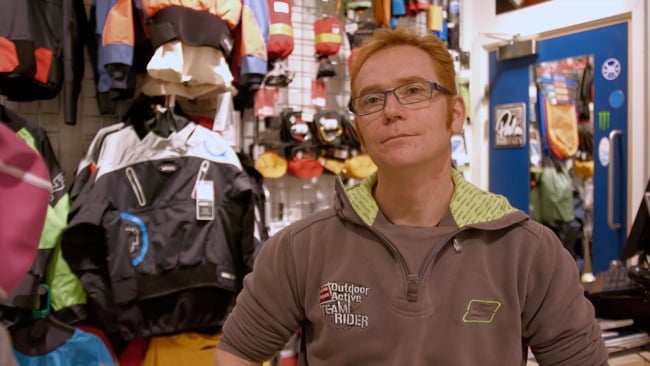
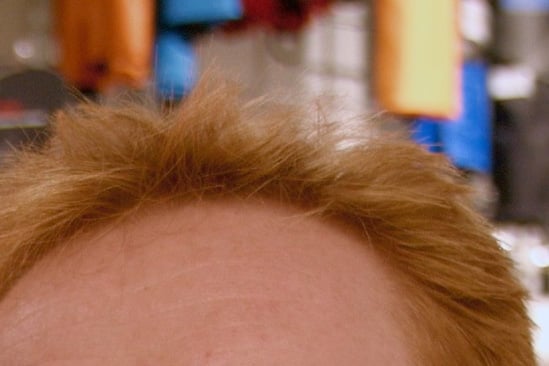
With all that said, the picture from the URSA is tack sharp with extremely fine detail on show. I noticed some slight moire on very fine pattern detailing at the highest frequencies, but overall you could not accuse the URSA of being soft.
Skin tones are also very pleasing and natural. This is an area that Blackmagic really does seem to have got right.
Low light performance is per the other Blackmagic cameras: Limited. This is not a camera to use in nightclubs or dingy bars without extra lighting. This may come as a shock for people who think that lighting is only something that the old guys do and not the essential skill that it is! On the plus side, it means that you need less ND on daytime exterior shots.
Conclusions
The URSA is an amazing camera for the money. In spite of a few negatives mentioned above, for £4k, the specification that you are getting here is previously unheard of. But it comes with a few caveats, one of which is that a lot of your support gear will also need to be upgraded.
To put things into perspective, while the URSA itself may only cost £4k and you can use EF lenses readily, a tripod to support the weight of it fully rigged up could cost up to £2k. So, if you are upgrading from a DSLR or even any of the other Blackmagic cameras, you will likely need to be prepared for a major investment in bulkier equipment. If you are intending to operate handheld a lot, then something like an Easy Rig support system would be an might be an option to consider.
This upgrade consideration also extends to the battery systems, which with a choice between V-lock and Gold Mount, could easily cost you well over £1k for a good set of batteries and dual or more chargers. Add in the cost of a good third party EVF, such as the Alphatron, and a decent number of CFast 2 cards and things could run away with you a bit. So be prepared to consider all of this.
CFast 2 cards should hopefully come down in price in time, as more devices start to use them. But, for the time being, they are an expensive proposition and are more pricey than the equivalent sized SSD.
For those people who already own an ENG camera (or Sony F5/55 etc), then you will more than likely have most of the support equipment already in place. And, in reality, it is this type of market where the URSA is really aimed.
Your final consideration will be whether to go for the URSA or one of the pricier rivals.
A lot will depend on the types of shoot that you do. The URSA's rivals are lighter weight, and, in some cases, more capable in the areas of low light, noise, dynamic range or framerate. Some of them require less investment in support gear, too, or at least may be more readily capable of utilising the support gear that you already have.
This begs the question of what value the URSA has? If you already have the support equipment and battery system, as well as preferring the larger form factor, you'll be flying. The ace up the URSA's sleeve is the interchangeable sensor block and huge amounts of redundant processing power available for future upgrades.
It may well be that the ability to upgrade to future better performing sensors may offset the cost of purchasing better support equipment, when weighed up against possibly having to buy a totally new camera every couple of years to keep up with the Joneses.
The decision will ultimately be yours, but what I can say is that the URSA, with its modularity and future-proofing, still represents incredible value for the money you pay for it and should be on your list for consideration.
(Thanks to Blackmagic for the loan of the camera and to Zeiss for the use of their Zeiss CP.2 50mm lens!)
URSA at 80fps in low light
Tags: Production


Comments